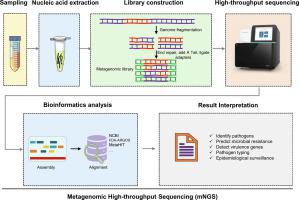Journal of Advanced Research ( IF 11.4 ) Pub Date : 2021-09-27 , DOI: 10.1016/j.jare.2021.09.011 Dongsheng Han 1, 2, 3 , Zhenli Diao 1, 4, 5 , Huiying Lai 6 , Yanxi Han 1, 4 , Jiehong Xie 1, 4 , Rui Zhang 1, 4 , Jinming Li 1, 4

|
Introduction
Metagenomic next-generation sequencing (mNGS) assay for detecting infectious agents is now in the stage of being translated into clinical practice. With no approved approaches or guidelines available, laboratories adopt customized mNGS assays to detect clinical samples. However, the accuracy, reliability, and problems of these routinely implemented assays are not clear.
Objectives
To evaluate the performance of 90 mNGS laboratories under routine testing conditions through analyzing identical samples.
Methods
Eleven microbial communities were generated using 15 quantitative microbial suspensions. They were used as reference materials to evaluate the false negatives and false positives of participating mNGS protocols, as well as the ability to distinguish genetically similar organisms and to identify true pathogens from other microbes based on fictitious case reports.
Results
High interlaboratory variability was found in the identification and the quantitative reads per million reads (RPM) values of each microbe in the samples, especially when testing microbes present at low concentrations (1 × 103 cell/ml or less). 42.2% (38/90) of the laboratories reported unexpected microbes (i.e. false positive problem). Only 56.7% (51/90) to 83.3% (75/90) of the laboratories showed a sufficient ability to obtain clear etiological diagnoses for three simulated cases combined with patient information. The analysis of the performance of mNGS in distinguishing genetically similar organisms in three samples revealed that only 56.6% to 63.0% of the laboratories recovered RPM ratios (RPMS. aureus/RPMS. epidermidis) within the range of a 2-fold change of the initial input ratios (indicating a relatively low level of bias).
Conclusion
The high interlaboratory variability found in both identifying microbes and distinguishing true pathogens emphasizes the urgent need for improving the accuracy and comparability of the results generated across different mNGS laboratories, especially in the detection of low-microbial-biomass samples.
中文翻译:

用于无偏微生物检测的宏基因组下一代测序的多实验室评估
介绍
用于检测传染原的宏基因组下一代测序 (mNGS) 分析目前正处于转化为临床实践的阶段。由于没有获得批准的方法或指南,实验室采用定制的 mNGS 检测来检测临床样本。然而,这些常规实施的检测的准确性、可靠性和问题尚不清楚。
目标
通过分析相同的样品来评估 90 个 mNGS 实验室在常规测试条件下的性能。
方法
使用 15 个定量微生物悬浮液产生了 11 个微生物群落。它们被用作参考材料来评估参与 mNGS 协议的假阴性和假阳性,以及区分基因相似的生物体和根据虚构病例报告从其他微生物中识别真正病原体的能力。
结果
在样品中每种微生物的鉴定和每百万读数的定量读数 (RPM) 值中发现了很高的实验室间变异性,尤其是在测试以低浓度(1 × 10 3细胞/ml 或更低)存在的微生物时。42.2% (38/90) 的实验室报告了意想不到的微生物(即假阳性问题)。只有 56.7% (51/90) 至 83.3% (75/90) 的实验室表现出足够的能力对三个模拟病例结合患者信息获得明确的病因诊断。对 mNGS 在区分三个样本中遗传相似生物体方面的性能分析表明,只有 56.6% 至 63.0% 的实验室恢复了 RPM 比率(RPM S. aureus /RPM S. epidermidis) 在初始输入比率的 2 倍变化范围内(表明偏差水平相对较低)。
结论
在鉴定微生物和区分真正的病原体方面发现的高实验室间变异性强调了提高不同 mNGS 实验室产生的结果的准确性和可比性的迫切需要,特别是在检测低微生物生物量样品方面。







































 京公网安备 11010802027423号
京公网安备 11010802027423号